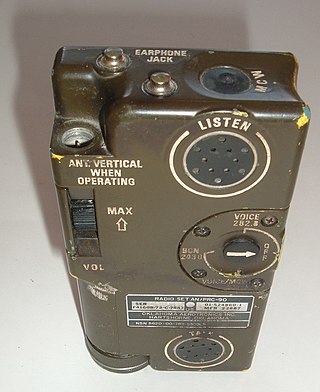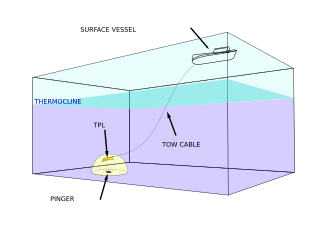
An emergency position-indicating radiobeacon (EPIRB) is a type of emergency locator beacon for commercial and recreational boats, a portable, battery-powered radio transmitter used in emergencies to locate boaters in distress and in need of immediate rescue. In the event of an emergency, such as a ship sinking or medical emergency onboard, the transmitter is activated and begins transmitting a continuous 406 MHz distress radio signal, which is used by search-and-rescue teams to quickly locate the emergency and render aid. The signal is detected by satellites operated by an international consortium of rescue services, COSPAS-SARSAT, which can detect emergency beacons anywhere on Earth transmitting on the distress frequency of 406 MHz. The satellites calculate the position or utilize the GPS coordinates of the beacon and quickly passes the information to the appropriate local first responder organization, which performs the search and rescue. As Search and Rescue approach the search areas, they use Direction Finding (DF) equipment to locate the beacon using the 121.5 MHz homing signal, or in newer EPIRBs, the AIS location signal. The basic purpose of this system is to help rescuers find survivors within the so-called "golden day" during which the majority of survivors can usually be saved. The feature distinguishing a modern EPIRB, often called GPIRB, from other types of emergency beacon is that it contains a GPS receiver and broadcasts its position, usually accurate within 100 m (330 ft), to facilitate location. Previous emergency beacons without a GPS can only be localized to within 2 km (1.2 mi) by the COSPAS satellites and relied heavily upon the 121.5 MHz homing signal to pin-point the beacons location as they arrived on scene.
A distress signal, also known as a distress call, is an internationally recognized means for obtaining help. Distress signals are communicated by transmitting radio signals, displaying a visually observable item or illumination, or making a sound audible from a distance.

A non-directional beacon (NDB) or non-directional radio beacon is a radio beacon which does not include inherent directional information. Radio beacons are radio transmitters at a known location, used as an aviation or marine navigational aid. NDB are in contrast to directional radio beacons and other navigational aids, such as low-frequency radio range, VHF omnidirectional range (VOR) and tactical air navigation system (TACAN).

Rescue comprises responsive operations that usually involve the saving of life, removal from danger, liberation from restraint, or the urgent treatment of injuries after an incident. It may be facilitated by a range of tools and equipment necessary to deal with the specific circumstances.

Direction finding (DF), or radio direction finding (RDF), is the use of radio waves to determine the direction to a radio source. The source may be a cooperating radio transmitter or may be an inadvertant source, a naturally-occurring radio source, or an illicit or enemy system. Radio direction finding differs from radar in that only the direction is determined by any one receiver; a radar system usually also gives a distance to the object of interest, as well as direction. By triangulation, the location of a radio source can be determined by measuring its direction from two or more locations. Radio direction finding is used in radio navigation for ships and aircraft, to locate emergency transmitters for search and rescue, for tracking wildlife, and to locate illegal or interfering transmitters. During the Second World War, radio direction finding was used by both sides to locate and direct aircraft, surface ships, and submarines.
The aircraft emergency frequency is a frequency used on the aircraft band reserved for emergency communications for aircraft in distress. The frequencies are 121.5 MHz for civilian, also known as International Air Distress (IAD), International Aeronautical Emergency Frequency, or VHF Guard, and 243.0 MHz—the second harmonic of VHF guard—for military use, also known as Military Air Distress (MAD), NATO Combined Distress and Emergency Frequency, or UHF Guard. Earlier emergency locator transmitters used the guard frequencies to transmit. As of February 1, 2009 satellite monitoring of the 121.5 and 243 MHz ELT (EPIRB) frequencies ceased, whereas an additional band from 406.0 to 406.1 MHz is now used exclusively by modern emergency locator transmitters (EPIRB).

The International Cospas-Sarsat Programme is a satellite-aided search and rescue (SAR) initiative. It is organized as a treaty-based, nonprofit, intergovernmental, humanitarian cooperative of 45 nations and agencies. It is dedicated to detecting and locating emergency locator radio beacons activated by persons, aircraft or vessels in distress, and forwarding this alert information to authorities that can take action for rescue. Member countries support the distribution of distress alerts using a constellation of around 65 satellites orbiting the Earth which carry transponders and signal processors capable of locating an emergency beacon anywhere on Earth transmitting on the Cospas-Sarsat frequency of 406 MHz.
Cobham Limited is a British aerospace manufacturing company based in Bournemouth, England.
Ultra Electronics Holdings is a British defence and security company. It was listed on the London Stock Exchange and was a constituent of the FTSE 250 Index until it was acquired by Cobham, which is itself owned by Advent International.

In navigation, a radio beacon or radiobeacon is a kind of beacon, a device that marks a fixed location and allows direction-finding equipment to find relative bearing. But instead of employing visible light, radio beacons transmit electromagnetic radiation in the radio wave band. They are used for direction-finding systems on ships, aircraft and vehicles.

An avalanche transceiver or avalanche beacon is a type of emergency locator beacon, a radio transceiver operating at 457 kHz for the purpose of finding people buried under snow. They are widely carried by skiers, particularly back country skiers for use in case a skier is buried by an avalanche. Before setting out on an expedition, all the members of a group activate their transceivers in the transmit mode, causing the device to emit low-power pulsed radio signals during the trip. Following an avalanche, if some members of the ski party are buried, the others may switch their transceivers from transmit into receive mode, allowing use as a radio direction finding device to search for signals coming from the lost skiers. The avalanche beacon is an active device powered by batteries; a ski suit may also contain a passive RECCO transponder sewn into the clothing.
An international distress frequency is a radio frequency that is designated for emergency communication by international agreement.
ENOS stands for "Elektronisches Notruf- und Ortungssystem" – "Electronic Rescue and Location System" - a system developed in Germany for use by divers at sea. ENOS allows people in distress to signal their location when drifting on the ocean's surface so they can be quickly located and rescued. Although the system was especially developed for scuba diving it can also be used for other water sports like windsurfing, jet skiing, sailing and boating.

Survival radios are carried by pilots and search and rescue teams to facilitate rescue in an emergency. They are generally designed to transmit on international distress frequencies. Maritime systems have been standardized under the Global Maritime Distress Safety System. Civil and military organisation's utilized different frequencies to communicate and no infringement on either sector would take place. For emergencies involving civilian aircraft, the radio frequency used is VHF 121.5 MHz and for military aircraft incidents, the frequency used is UHF 243 MHz.

TJC, formerly known as The Jordan Company is a private equity firm focused on leveraged buyout and management buyout investments in smaller middle-market companies across a range of industries.

MACOM Technology Solutions, Inc. is a developer and producer of radio, microwave, and millimeter wave semiconductor devices and components. The company is headquartered in Lowell, Massachusetts, and in 2005 was Lowell's largest private employer. MACOM is certified to the ISO 9001 international quality standard and ISO 14001 environmental standard. The company has design centers and sales offices in North America, Europe, Asia and Australia.
HEICOCorporation is an American aerospace and electronics company, which manufactures products found in aircraft, spacecraft, defense equipment, medical equipment, and telecommunications systems. Since the mid-1990s, HEICO has been organized into two divisions to address these different markets: Flight Support Group and Electronic Technologies Group.
SEACOR Holdings, based in Fort Lauderdale, Florida, provides equipment and services to the offshore petroleum industry and the marine transportation industry. An American corporation, the company holds a 70% ownership stake in a bioethanol plant located in Illinois.

On 20 January 2014, a Britten-Norman Islander light aircraft belonging to the Superior School of Aviation in Romania operating Flight 111 crashed in the Apuseni Mountains at an altitude of approximately 1,400 metres (4,600 ft), near the village of Petreasa, between Alba and Cluj counties. The aircraft was piloted by two crew and was transporting a five-person medical team from Bucharest to Oradea. The pilot and a medical student died, while the copilot and four medical doctors were injured.

A towed pinger locator is a water-borne device used to locate the sonar "ping" from the underwater locator beacon which is fitted to the Cockpit Voice Recorders and Flight Data Recorders installed in commercial airliners. They can locate pingers at depths of up to 20,000 feet (6,100 m) underwater.











